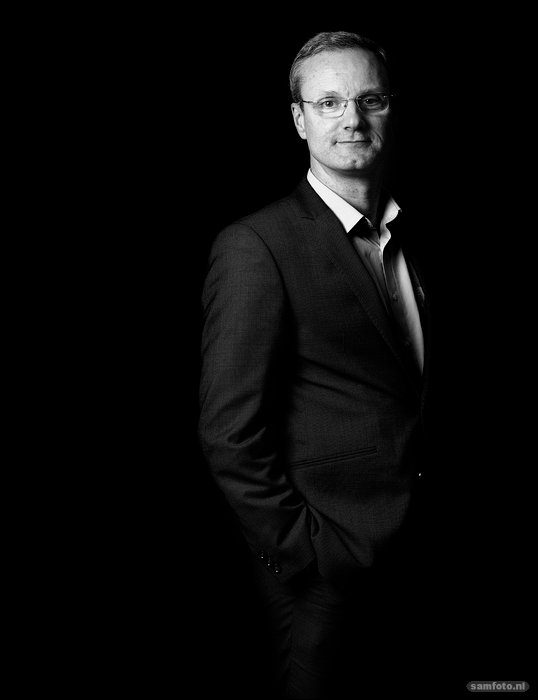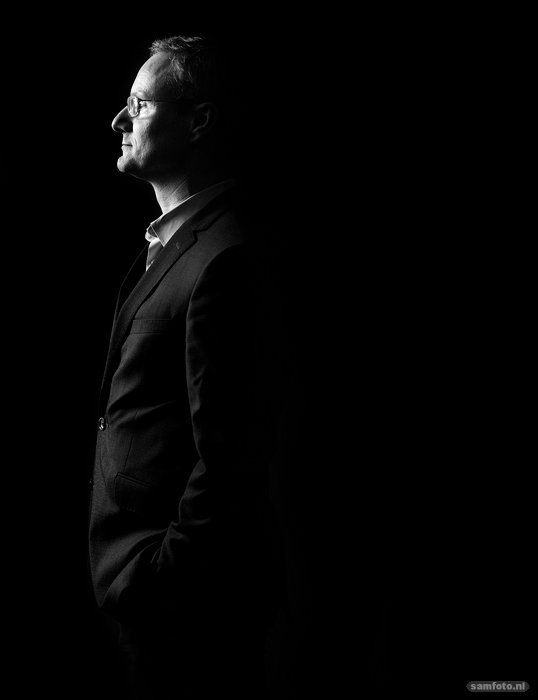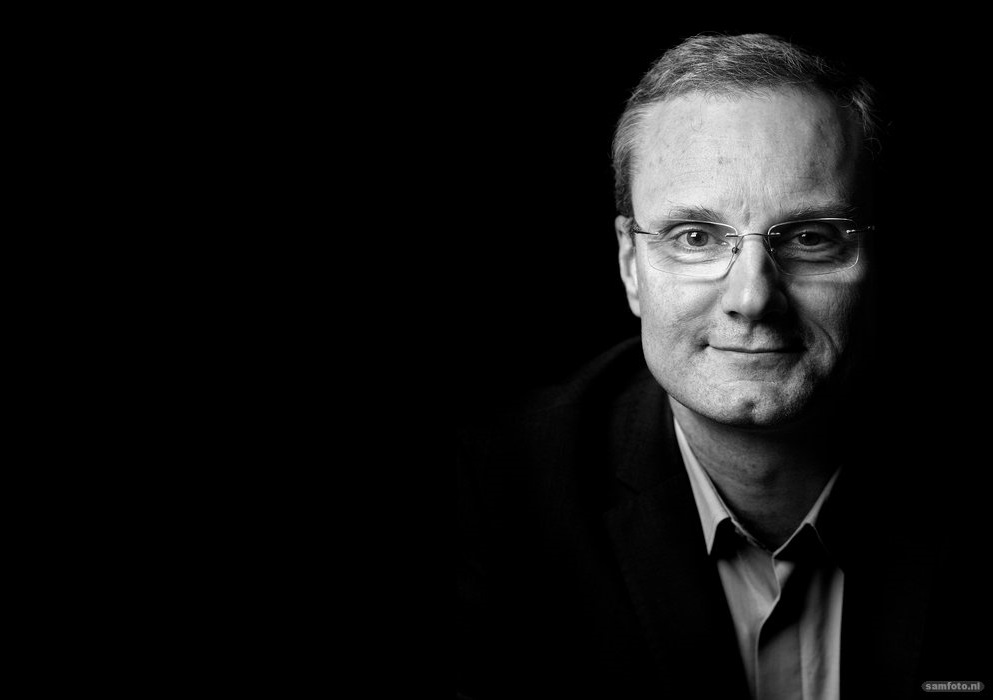On 7 November, Joris Melkert, lecturer and Educational Fellow at the Faculty of Aerospace Engineering, was voted TU Delft’s Best Teacher of 2019.
“After each section, I do a quiz where students can vote for the ugliest aircraft.” (Photos: Sam Rentmeester)
Congratulations. Right before the ceremony, you didn’t think you stood a chance.
“Statistically speaking, no. There’s only a very small chance that the winner would come from the Faculty of Aerospace Engineering two years in a row. I saw Jan Rots’ name on the list of nominees and thought he would win. He’s a great teacher and has more experience than I do.”
Your colleague Calvin Rans was last year’s teacher of the year. What’s your secret at Aerospace Engineering?
“I know he’s a great teacher. Three years ago, I worked with him to revamp one of our difficult courses, Structural Analysis and Design – a nightmare for students. When one of the previous lecturers left, it turned out that both Calvin and I had said that we wanted to teach that course, to solve the problem.”


What did you do?
“I asked for an overview of the learning objectives, but there wasn’t one. Calvin and I were involved in the final assignment in the Bachelor’s third year, a design exercise, and we both saw that students really struggled with it.
They could analyse a structure, but didn’t know how to design it. We split the course into two parts and gave more examples about designing from scratch. We then started doing six two-hour voluntary workshops, on Friday afternoons. Students who take part in those have a better chance of passing the exam.”
What lecturer inspired you?“
Professor Hans Wittenberg was very good. He really was a talented lecturer. The way he structured his lessons and wrote derivations neatly on the board in chalk – a born teacher.”
Have you borrowed any of his methods?
“I use some of his jokes. In those days we had two chalkboards. If the board at the front was full, you’d slide it up and use the board behind it. But the frame wasn’t that high, so you’d have to get lower and lower to write on the back board. At one point, Wittenberg was crouched on his knees writing out formulas and said: ‘This formula is so beautiful, you have to bow down to it.’ (Laughs) I use that joke every now and again. He also had a special chalk jacket, because he sometimes came out of that lecture room covered in dust.”
How do you keep the students engaged?
“In the first-year Dynamics course I use two tricks. Firstly, I ask mini multiple-choice questions in between, online. Actively participating will get you a quarter of a bonus point. This is mainly about feedback. Students know where they stand and I know whether they have understood the material. The second trick I use is the ugly aircraft competition, an idea that I stole from a French test pilot who had to tell a boring story. After each section, I do a quiz where students can vote for the ugliest aircraft. I’ve pre-selected forty. In the following quarter, I teach the aircraft design course. One of the things you have to learn is to look at aircraft. Why is the undercarriage where it is? Why is that wing so big? Telling them something about each of those forty aircraft is a good way to prepare them for that course.”
‘I expected it to really take off, but that wasn’t the case’
You also help Master’s students construct a two-person aircraft. Why?
“I do that as part of my Education Fellowship (a TU Delft grant for educational innovation, ed.). We used to see lots of new types of aircraft on the market. They then became more complex and developments slowed down. Now you see only a few new types, but there is enormous growth.
Producing aircraft properly is becoming more important. That means you need engineers who can oversee that process. That’s why we’ve started an ‘aircraft factory’ with a kit for a two-person aircraft, where everything is done in the same way as in a normal aircraft factory. Everything is certified: staff, materials, design, documentation, tools and training.”
What do the students think about it?
“I expected it to really take off, but that wasn’t the case. The students who participate are incredibly enthusiastic, but you can see that they have difficulty with the fact that they have to take responsibility for the first time. People will die if you make a mistake, to put it bluntly. It’s the first time they’re confronted with that.”


You teach about six courses, supervise graduating students, coordinate the Bachelor’s graduation project and are a member of all kinds of associations and boards. And you took part in the climate accord talks, you’re often in the media giving explanations and, according to students, you ‘always have time for a chat’. Where do you find the time?
“I very rarely leave here before 20.00. I always say that I work half-days, from 9.00 to 21.00. You get used to it. I don’t have a wife and children, so that helps.”
What can be done to maintain the quality of teaching today?
“The numerus fixus is set at 440 but in this box (he points to a box full of exams, ed.) there are 480 exams taken by first-year students alone.”
Have we reached the limit?
“At times, yes. Individual attention is really a thing of the past. My biggest fear is that we will end up reviewing our teaching every year. ‘It’s busy and we also have to do some research, so let’s cut a few corners.
It’ll be fine.’ And then again next year, and the year after that. You run the risk of looking back in fifteen years’ time and thinking: how did we let it come to this?”
‘Flying is the new smoking’ and we all know the phrase ‘flight shame’. How are you tackling that in your courses?
“That’s the biggest challenge of the future. The bad news is there’s no quick-fix. You can’t just put a few batteries in planes. The good news is that there’s a lot we can do. The real challenge is that, on the one hand, aircraft are getting better and carbon emissions are decreasing by about 1% a year, but on the other, aviation is growing by 5% a year. The second problem is that turnovers are high but profits are small. Worldwide, the net profit on a ticket is less than a tenner. That leaves little room for innovation.”
How do you balance that?
“There is no magic solution. You need more research and development. You need to invest. The planned flight tax is supposed to go towards innovation. We will have to introduce new aircraft more quickly, because they are cleaner, quieter, more economical and therefore cheaper.
We need to look at alternative fuels, stop detours and switch to a single European airspace. That on its own could achieve savings of between 5% and 10%. But there’s a lack of political willingness to get it done. It’s a disgrace. We need more legislation and regulations and more social pressure. The best thing would be if that growth would slow down in the short term, so that we can catch up with innovations. That means that you will need well-trained people who also think about sustainability.”
Do you have any tips for other lecturers?
“Observe your colleagues. I used to go watch Wubbo Ockels. There are a lot of good teachers here. You can learn a lot from Calvin Rans, too.”
This interview appeared in the December issue of Delft Outlook, the TU Delft alumni magazine
Joris Melkert refers to his year of birth, 1969, as “a fantastic year for aviation” due to the first Concorde and the Boeing 747. He claims that 747s will still be in the sky when he dies. “And I plan on living a long time.” Melkert graduated in 1992 with a project on a glider that can do measurements in the stratosphere. He’s been teaching ever since. After Fokker went into liquidation, he header a faculty office for strategic development to tackle declining student numbers. In mid-2004 he joined Ockels’ chair in Aerospace for Sustainable Engineering and Technology. Now he’s a full-time lecturer at Flight Performance and Propulsion.
Do you have a question or comment about this article?
c.j.c.vanuffelen@tudelft.nl


Comments are closed.